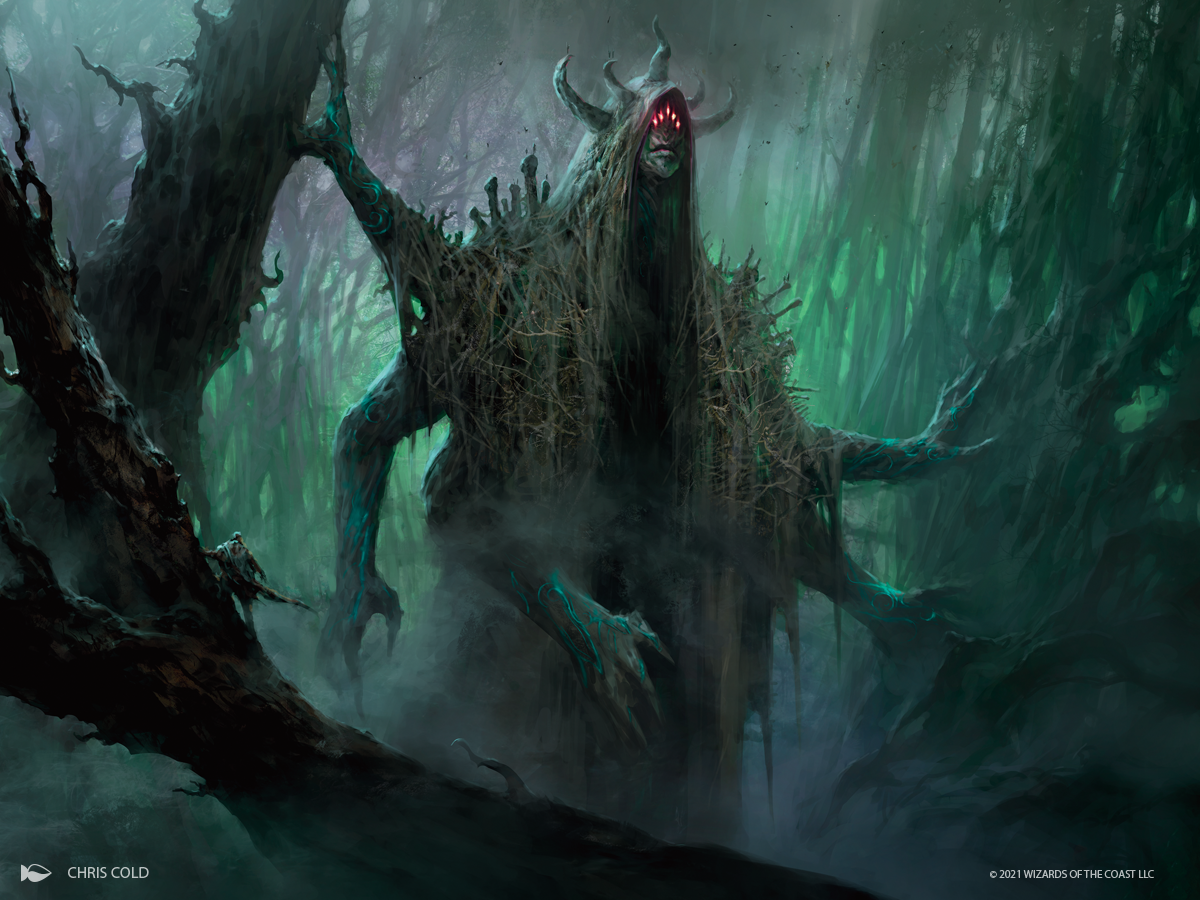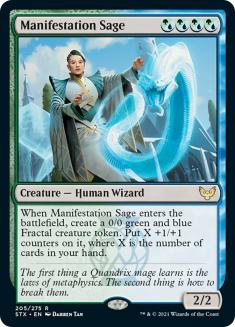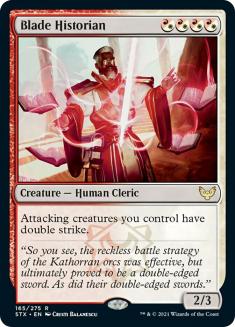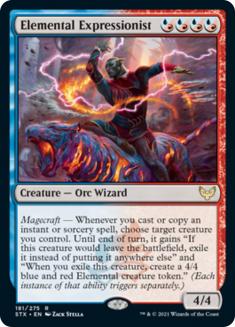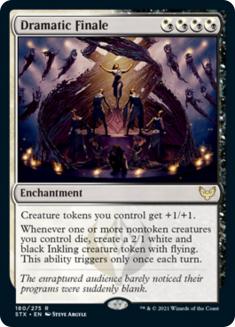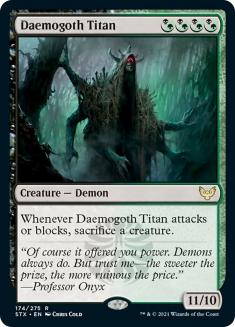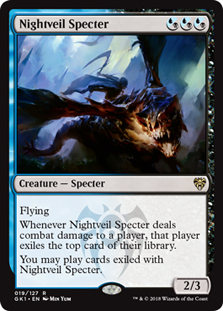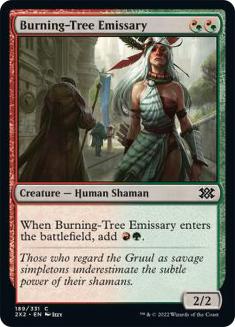Strixhaven really has its work cut out for it in Standard. For the most part, there just isn’t the typical single card power we expect to see in a recent set. Some of the solid removal here will slide into existing archetypes, and maybe there’s even a secondary engine or redundant effect that can add a wrinkle to Temur Adventures or Sultai Ramp (Yorion)’s gameplan. But if Strixhaven is going to have an impact on Standard and create new archetypes, it will have to do so by providing support for existing cards that were previously lacking sufficient enablers. And no set of cards is about to receive more support than those focused on the Devotion mechanic.
Devotion’s second go around in Standard has not yielded the same fruit as it did when we first explored the mechanic in the original Theros block. In that era, black, green, red, and blue all had extremely successful decks focused on the mechanic. Some of this was based on the quality of the original Theros gods, but I’d argue the hybrid support cards were far more important in making these archetypes into top tier contenders.
The dramatic increases in the density of “pips” that came from these cards was essential for making the spells present in these Devotion decks comparable to extremely powerful multicolored options like Rakdos’s Return and Sphinx’s Revelation. Sure, Nykthos, Shrine to Nyx helped along the process too, but the point is you couldn’t really even consider playing devotion cards unless you had access to a way to maximize mana symbols. Presently, the largest source of pips for most Devotion strategies is found in nine Throne of Eldraine uncommons (Dimir got Covetous Urge for its member of the cycle) that can only be described as the most medium of medium options. These new Strixhaven options are of varying quality to be sure, but they mostly outshine the existing crew, and when the primary goal is adding pips on the battlefield, incremental improvements in the secondary applications of the card can be worth a lot. I want to share a few options I’ve been working on that might have what it takes to bring Devotion back into the limelight.
Blade Historian strikes me as the strongest card in the cycle, and a large part of this is because of how quickly it creates problematic damage in conjunction with Heliod, Sun-Crowned.
Creatures (31)
- 4 Giant Killer
- 2 Daxos, Blessed by the Sun
- 4 Heliod, Sun-Crowned
- 4 Alseid of Life's Bounty
- 4 Seasoned Hallowblade
- 3 Selfless Savior
- 4 Skyclave Apparition
- 2 Usher of the Fallen
- 4 Blade Historian
Lands (24)
- 24 Plains
Spells (5)

Of course, we already have a Mono-White Aggro deck in Standard, so is there enough of a reason to shift to the combination of Heliod and Blade Historian? As always, the frustrating answer is “it depends”. If Heliod’s indestructibility and incidental lifegain becomes important, I could certainly see shifting in this direction. It’s a big ask to give up Faceless Haven in these decks though. I think it’s reasonable to still play Snow-Covered Plains in the maindeck and look for spots where Faceless Haven can be part of our sideboard plan, but that’s going to have a lot to do with how the format evolves. I’d still start on default Mono-White Aggro❄ for the time being, but this could be an interesting wrinkle to have in your back pocket.
Another potential home for Blade Historian is along side Winota, Joiner of Forces. While more traditional Boros Winota decks have their appeal, I wonder if we can splice in devotion to the mix.
Creatures (34)
- 1 Giant Killer
- 3 Daxos, Blessed by the Sun
- 4 Heliod, Sun-Crowned
- 4 Reverent Hoplite
- 4 Alseid of Life's Bounty
- 4 Winota, Joiner of Forces
- 4 Selfless Savior
- 4 Skyclave Apparition
- 2 Usher of the Fallen
- 4 Blade Historian
Lands (24)
Spells (2)

I’m not a huge fan of the Snarls in this iteration of Standard, but they do a fantastic job of enabling single splashes in decks like this. You might talk me into a Mountain depending on how many red sideboard cards I’m looking to play, but I love how clean this is for casting our Daxos, Blessed by the Sun and Skyclave Apparitions. Reverent Hoplite should allow this deck some explosive combo turns, especially if you happen to get Daxos and Heliod into the mix. That’s asking for a lot to go right though, and admittedly some of the timing you’ll run into is apt to be awkward. Maybe the card quality is good enough that it won’t matter?
90% of why white is so appealing is the fact that we get to curve Turn 3 Heliod into Turn 4 Devotion enabler, so we’ve got to at least consider the fact that Blade Historian isn’t our only chance to make this move.
Creatures (25)
- 4 Giant Killer
- 2 Daxos, Blessed by the Sun
- 4 Heliod, Sun-Crowned
- 2 Reverent Hoplite
- 3 Skyclave Apparition
- 2 Clarion Spirit
- 4 Usher of the Fallen
- 4 Professor of Symbology
Planeswalkers (2)
Lands (21)
- 21 Plains
Spells (12)

Tokens are obviously not carrying a mana cost with them so building around Dramatic Finale certainly has some tension with the idea of creating devotion. The fact that Dramatic Finale creates the devotion payoff for Heliod singlehandedly gives us some wiggle room though. One of the few Strixhaven cards that really caught my eye in preview season was Professor of Symbology. This is my first chance to give the card a shot, and I was shocked how well my options played with the themes here. Not only do we have four separate token makers, we even have a way to gain life to trigger Heliod. I could see taking the “free” black splash from Shineshadow Snarl and Brightclimb Pathway to also slot in Confront the Past if I was lacking other good sideboard options.
I’m more interested in Dramatic Finale in white than black. If I’m trying to make things happen with black devotion, I’m all-in on Daemogoth Titan.
Creatures (27)
- 2 Gray Merchant of Asphodel
- 3 Murderous Rider
- 1 Ayara, First of Locthwain
- 1 Tymaret, Chosen from Death
- 4 Fiend Artisan
- 1 Lurrus of the Dream-Den
- 4 Archfiend's Vessel
- 4 Acquisitions Expert
- 1 Skyclave Shade
- 2 Elderfang Disciple
- 4 Daemogoth Titan
Lands (22)
Spells (11)

I feel like I’ve attempted a lot of this before, but I do think Silverquill Command and Daemogoth Titan move the needle. Silverquill Command is my pick for most powerful of the Command cycle. Here, it accomplishes so many things for us. It keeps the attrition plan going from our Elderfang Disciples and Acquisition Experts. It keeps one of our core engines on the battlefield in Fiend Artisan. It makes sure we have ample fodder available for when Daemogoth Titan is ready to go on offense. And most importantly, it lets Daemogoth Titan pick up a useful +3/+3 and flying. If you get a Daemogoth attack to connect with your opponent, odds are very good that a Gray Merchant of Asphodel is able to find lethal. This deck really asks the format to be generally lacking in spot removal, and slightly less aggressive. If those boxes are checked, I could see this deck being reasonably competitive.
Looking at blue, red, and green, for the most part we start to be lacking in Devotion payoffs besides the Gods. I know Mono-Blue Devotion has floated around the fringes of playability for a while, but due to that deck’s focus on Nyx Lotus and Corridor Monitor, it prefers Arcanist Owl. Sadly, I think blue is being left out in the cold for upgrades here.
Green is left in a bizarre spot when it comes to Devotion. Old-Growth Troll and Manifestation Sage are solid inclusions in a Mono-Green Devotion list that’s looking to get aggressive, but Nylea, Keen-Eyed has its effectiveness hampered by the fact that your creatures are so dense in Green pips. Is it possible that the payoff here is actually Setessan Petitioner?
Creatures (29)
- 4 Gilded Goose
- 4 Lovestruck Beast
- 4 Setessan Petitioner
- 3 Elder Gargaroth
- 2 Tangled Florahedron
- 4 Kazandu Mammoth
- 4 Old-Growth Troll
- 4 Manifestation Sage
Lands (21)
Spells (10)

Having put together this list, I think the answer is a pretty clear no. I will say, I’m somewhat of a believer in the raw power of Fortifying Drought though. It’s baseline functionality is just barely too weak for Standard, as Giant Growth has seen very occasional play. However, the ceiling here is impressive. It’s almost Aspect of Hydra-esque with a better fail case… although given the quality of our Devotion enablers, I’d gladly swap Fortifying Drought for Aspect of Hydra. I expect to come back to Fortifying Drought in non-devotion shells though. It’s a shame that the payoffs just aren’t there for either Mono-Blue or Mono-Green because I think Manifestation Sage is a decent standalone threat in many scenarios. This one is just another example of a list that gives up too many powerful cards to try something fancy.
In red, I can at least come up with a plausible reason to look at these devotion enablers since they might function as decent cards on their own. I don’t think either of these looks can match the impact of playing Faceless Haven in the archetype, but here’s a draft of what red decks built around Blade Historian and Elemental Expressionist might look like.
Creatures (24)
- 4 Fervent Champion
- 4 Bonecrusher Giant
- 4 Rimrock Knight
- 4 Anax, Hardened in the Forge
- 4 Fireblade Charger
- 4 Elemental Expressionist
Lands (22)
- 22 Mountain
Spells (14)

There’s really nothing all that revolutionary in this list. We’re just trying to make our Anax, Hardened in the Forge slightly larger and make blocking a little more tricky for our opponents. Is this approach worth it over Torbran, Thrane of Red Fell and Faceless Haven? Almost certainly not.
Creatures (26)
- 2 Robber of the Rich
- 4 Fervent Champion
- 4 Bonecrusher Giant
- 4 Rimrock Knight
- 4 Anax, Hardened in the Forge
- 4 Fireblade Charger
- 4 Blade Historian
Lands (23)
Spells (11)

This version of Mono-Red at least does some things better than existing lists, and I think you could reasonably consider playing it without being laughed out of the room. If you squint really hard, Blade Historian almost feels like additional copies of Embercleave, which is by far your most powerful card. Once we’re leaning into double strike, the almost playable Infuriate crosses the threshold where I’m willing to pick up a couple copies. If opponents are inclined to ignore your battlefield and just trying to go big on Turn 5 or 6 (think Sultai Ramp), there’s a good argument for setting up your deck to always “have it” on Turn 4 or 5. You’ll give up the staying power of Faceless Haven, but that’s not going to be important in every metagame.
Some of these decks seem reasonable in the abstract, but I concede that the non-white builds are really playing from behind in comparison to decks built around either Throne of Eldraine cards or Faceless Haven. That’s just going to be our reality for a while. I still think we owe it to ourselves to do our due diligence on the new additions to the format. Even if very few of these ideas are going to bear fruit, it only takes one success to turn the format as we know it on its ear. I could see the Heliod lists here potentially getting the job done, but maybe we should all be paying more attention to Silverquill Command.

